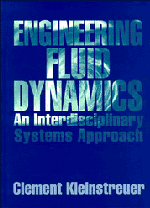Book contents
- Frontmatter
- Contents
- Preface
- List of Symbols and Abbreviations
- Chapter 1 Preliminary Concepts
- Chapter 2 Derivations and Transformations of the Conservation Equations
- Chapter 3 Analyses of Basic Fluid Flow Problems
- Chapter 4 Nonisothermal Flows
- Chapter 5 Selected Case Studies
- Appendix A Differential Operators and Cartesian Tensor Applications
- Appendix B Basic Equations in Rectangular, Cylindrical and Spherical Coordinates
- Appendix C Simplified Governing Equations
- Appendix D Stream Function Formulation in Planar and Axisymmetric Coordinates
- Appendix E Physical Properties of Gases and Liquids
- Appendix F Numerical Tools and Program Listings
- Index
Chapter 5 - Selected Case Studies
Published online by Cambridge University Press: 05 June 2012
- Frontmatter
- Contents
- Preface
- List of Symbols and Abbreviations
- Chapter 1 Preliminary Concepts
- Chapter 2 Derivations and Transformations of the Conservation Equations
- Chapter 3 Analyses of Basic Fluid Flow Problems
- Chapter 4 Nonisothermal Flows
- Chapter 5 Selected Case Studies
- Appendix A Differential Operators and Cartesian Tensor Applications
- Appendix B Basic Equations in Rectangular, Cylindrical and Spherical Coordinates
- Appendix C Simplified Governing Equations
- Appendix D Stream Function Formulation in Planar and Axisymmetric Coordinates
- Appendix E Physical Properties of Gases and Liquids
- Appendix F Numerical Tools and Program Listings
- Index
Summary
Chapter 5 attempts to extend the basic knowledge gained and (homework) problem solution skills acquired from studying Chapters 1 through 4 and using Appendices A to F. Section 5.1 deals with mathematical modeling aspects important for the development of computer simulation models, which are becoming more and more acceptable in solving complex fluid mechanics and convection heat transfer problems. The selected case studies begin with turbulent shear-layer flows applied to external curved surfaces (Sect. 5.2.1) and internal walls (Sect. 5.2.2). The basic idea of boundary-layer theory is then extended in Section 5.3 to non-Newtonian fluid flow with exothermal chemical reaction (Sect. 5.3.1) and with wall heat transfer (Sect. 5.3.2). The fifth and sixth case studies are more complicated, focusing on two-phase flows with moving gas–liquid interface due to droplet vaporization (Sect. 5.4.1) and moving liquid–solid interface due to ice formation (Sect. 5.4.2). The last two case studies represent the state of the art in (bio-) fluid dynamics applied to laminar pulsatile flow in branching blood vessels (Sect. 5.5.1) and temperature-driven flow in a local hyperthermia treatment device that is a concentric heated cylinder in a water-filled balloon (Sect. 5.5.2). Both biofluid flow systems are transient three-dimensional and hence require the numerical solution of the complete Navier–Stokes equations.
The open literature provides many additional case studies that encapsulate both basic knowledge in engineering fluid dynamics and computer solution steps for real-world (thermal) flow problems.
- Type
- Chapter
- Information
- Engineering Fluid DynamicsAn Interdisciplinary Systems Approach, pp. 353 - 456Publisher: Cambridge University PressPrint publication year: 1997



